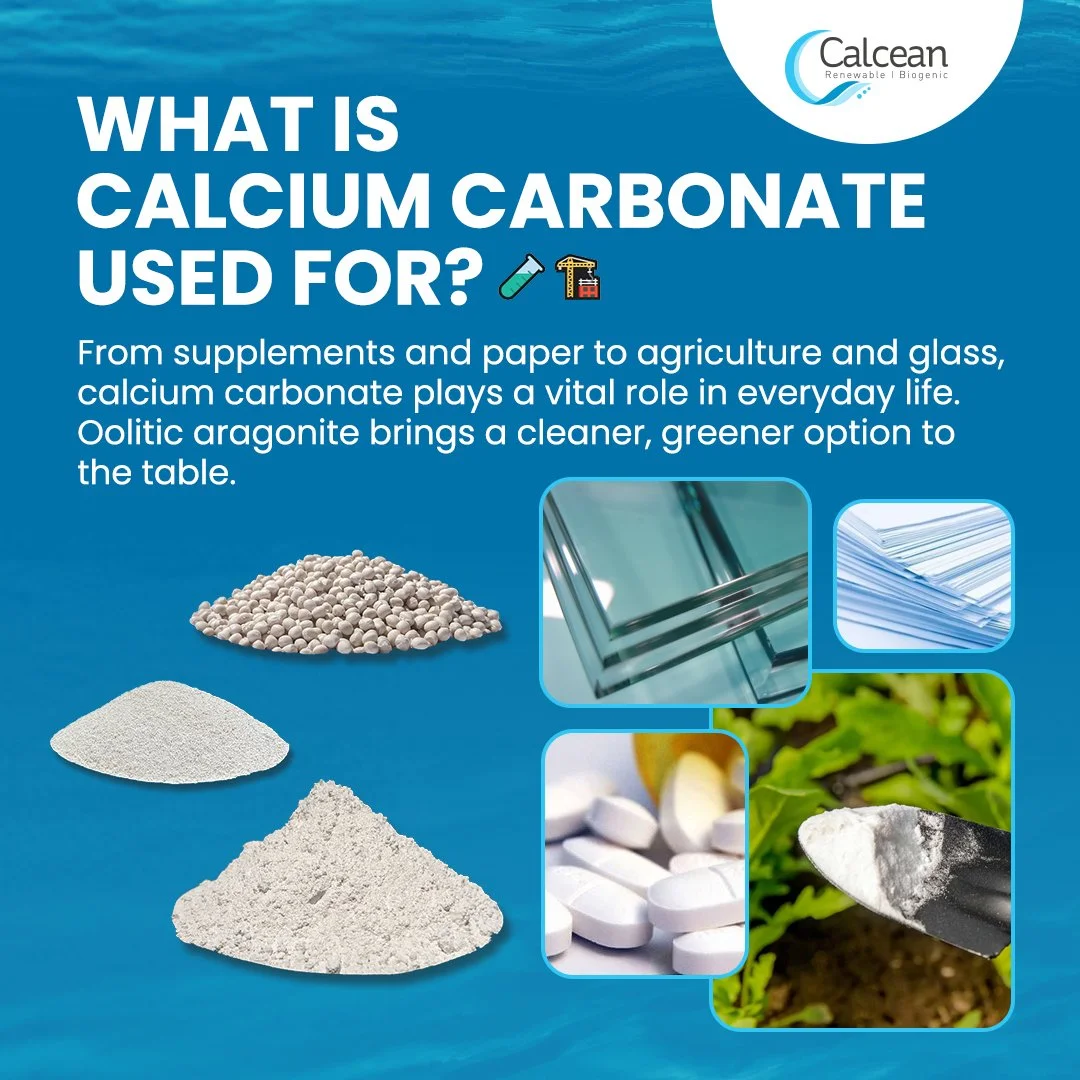What Is Calcium Carbonate Used For? (And Why Oolitic Aragonite Is the Natural Advantage)
You may know calcium carbonate as a white, chalky powder often found in antacids or chalkboard chalk—but this versatile mineral plays a starring role in dozens of industries, from construction and agriculture to food production and plastics.
Even more surprising? It’s found in things like toothpaste, wine, and even paper. Let’s explore some of the most common—and least expected—uses of calcium carbonate, and how oolitic aragonite, a pure and naturally renewable form of it, is offering a cleaner, smarter alternative for manufacturers and suppliers alike.
🏗️ 1. Construction & Building Materials
Used in: Concrete, asphalt, roofing shingles, and cement.
Calcium carbonate is a foundational component in construction—literally. It’s used as a mineral filler and aggregate enhancer, improving strength, durability, and workability in concrete and other mixes.
How oolitic aragonite helps:
Its uniform grain size and high purity make it an ideal performance additive in engineered building products. Plus, it’s lighter and climate positive compared to mined limestone.
🧼 2. Personal Care & Hygiene Products
Used in: Toothpaste, deodorant, makeup, and body scrubs.
As a mild abrasive and thickener, calcium carbonate is used to clean, exfoliate, and bind personal care products. It also acts as a pH adjuster in many formulations.
Surprising fact: That gentle grit in your toothpaste? Often calcium carbonate.
Oolitic advantage:
Our naturally occurring aragonite is climate positive, vegan, and processed with minimal environmental impact—making it perfect for clean beauty and eco-conscious brands.
🍼 3. Food & Beverage Processing
Used in: Antacids, calcium-fortified drinks, wine clarification, and baking powder.
Calcium carbonate is approved as a food additive and nutritional supplement, valued for its bioavailable calcium and gentle alkalinity. It’s also used to adjust pH and clarify liquids like wine and juice.
Why oolitic aragonite?
Its biogenic marine origin, high surface area and natural structure make it the calcium easier for the body to absorb compared to synthetic or mined forms. This is especially important in plant-based supplements and clean-label food products.
📦 4. Plastics & Polymers
Used in: Packaging films, plastic parts, and biodegradable materials.
In plastics, calcium carbonate is used as a filler and extender to lower cost, improve strength, and control opacity. It also improves the sustainability of certain bio-based plastics.
Oolitic aragonite’s edge:
Its bright white color, consistent particle size, and natural formation make it ideal for improving surface finish, reducing resin use, and reducing embodied carbon of sustainable packaging.
🌿 5. Agriculture & Soil Health
Used in: Soil conditioners, fertilizers, and livestock feed.
Calcium carbonate is applied to fields to neutralize soil acidity, improve nutrient absorption, and supply calcium for plant and animal health.
Oolitic aragonite benefit:
Compared to ground limestone, it’s more reactive, cleaner, and adds trace marine minerals. It supports regenerative agriculture, turf management, and organic growing.
🧪 6. Water Treatment & Environmental Applications
Used in: pH control, remineralization, filtration media.
Calcium carbonate is added to water to stabilize pH, reduce acidity, and support remineralization—especially in desalination and municipal treatment systems. It also readily adsorbs phosphates, helping to remediate nutrient polluted water ways.
Why aragonite is ideal:
It offers a natural and effective alternative to synthetic pH buffers or mined calcite in sensitive ecosystems. It naturally remediates waterways and can be used in run off areas to capture nutrients before polluting sensitive surrounding ecosystems.
🎨 7. Paper, Paint & Pigments
Used in: Paper coating, white paints, and inks.
Its high whiteness and brightness make calcium carbonate a critical ingredient in many coated papers and paints. It helps control gloss, opacity, and smoothness.
Oolitic advantage:
High-purity aragonite offers excellent optical properties, ideal for paints, paperboard, and graphic applications seeking eco-conscious, climate positive, and biogenic mineral inputs.
🔮 8. Glass Manufacturing
Used in: Window glass, bottles, fiberglass, and specialty glassware.
Calcium carbonate plays a vital role in glass production. It lowers the melting temperature of silica, making the process more energy-efficient. It also contributes calcium, which improves the chemical durability, hardness, and workability of the final glass product. The purity of the calcium carbonate is important as well. Low iron calcium carbonate is required for high clarity glass applications - like glass containers, float glass etc.
Surprising fact: Even your car windshield and drinking glass likely started with calcium carbonate.
How oolitic aragonite helps:
Thanks to its high purity, consistent grain size, and low iron, oolitic aragonite offers manufacturers a cleaner, more uniform alternative to traditional limestone or dolomite. Its natural formation makes it especially appealing for eco-conscious glassmakers aiming to reduce emissions and enhance quality and clarity.
🌍 A Cleaner Carbonate for a Changing World
As industries move toward more sustainable practices, the source and processing of materials matter more than ever. At Calcean, we offer oolitic aragonite harvested responsibly from marine deposits in The Bahamas—providing a renewable, low-impact alternative to mined calcium carbonate.
✔️ Lower environmental footprint (climate positive!)
✔️ Renewable marine source
✔️ Consistent particle size and high purity
✔️ Ideal for glass, beauty, building, and industrial uses
Ready to Learn More?
Whether you’re sourcing materials for bio-based manufacturing, formulating natural products, or seeking carbon-smart inputs for agriculture or construction, oolitic aragonite from Calcean offers a proven, powerful alternative.
➡️ Contact us!

